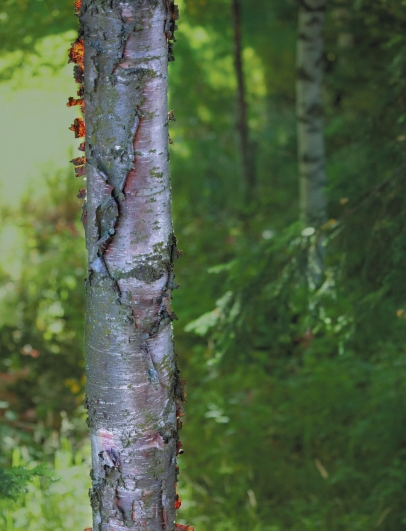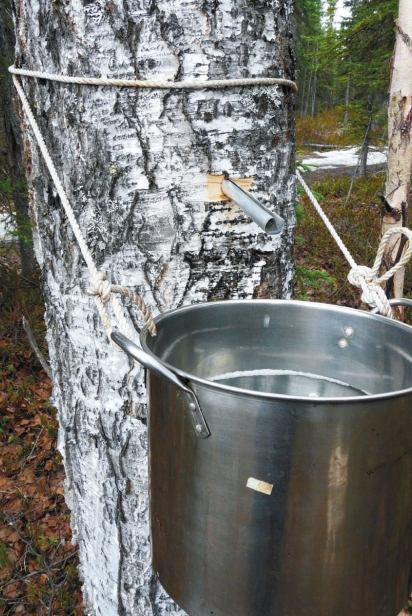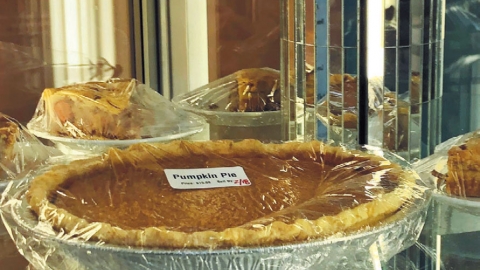Birch Birch Everywhere
As soon as break-up started in Fairbanks, my mantra became: “Birch, birch everywhere and not a drop to eat.” I’d spent the earlier part of the year interviewing commercial producers and home tappers for an Atlas Obscura article about birch tree tapping and syrup production in Alaska, and my personal takeaway from those conversations was fourfold: 1) tapping is easy and cheap, 2) the process is time intensive, 3) there is some science involved that can make you more successful in your efforts, and 4) there is an obscenely large ratio between birch sap and birch syrup. Like really big. Insurmountable.
As Fairbanks began to experience near record-breaking warmth in March, I chose to focus on how easy and cheap it would be to tap trees at our house and less on the other three critical features of birch tree tapping.
I’m not exactly a novice when it comes to food systems. Almost 20 years ago I worked as a WWOOFer (willing workers on organic farms) in Hawaii. In graduate school, I co-initiated a community garden in Detroit. I’ve participated actively in numerous community-supported agriculture groups and food cooperatives across the country. Maybe I’m not a food grower, but I am food grower adjacent. I know people who grow and make things from the land.
So while I already had the vision in my mind of tapping at least a few of the 50-plus birch trees on our property, my syrup fantasy became more urgent when my husband unearthed, deep in our liquor cabinet, an unopened bottle of Björk, an Icelandic liquor made from birch sap. It was then that I was certain that our future involved turning our home into a distillery and marketing our homegrown Alaskan birch liquor to unspeakable amounts of winter tourists.
On March 23, 2019, I received an email from Jan Dawe, the director of OneTree Alaska, an education, research, and outreach program of the University of Alaska Fairbanks School of Natural Resources and Extension, with the subject line, “2019 Birch sap season coming early!” Dawe’s email explained, “With the daily maximum temperature in Fairbanks at or above freezing every day since March 8, we’ll likely have the earliest sap season on record, so it’s time to pick up gear. For those of you living on south-facing slopes, plan to set your taps out the weekend of March 30-31. For those living on north- or west-facing slopes, plan to set your taps out the first weekend in April.”
Many months after receiving her email, while on the phone with Dawe, I shared with her that after I read that the tapping season was upon us, I frantically went to purchase spiles, but then went out of town and thus didn’t tap my north-facing trees until around April 5. She excitedly explained to me that I probably (accidentally) tapped my trees at exactly the right time. Dawe also indicated that the reason for the delay between when the temperature is above freezing and when one should tap is it’s best to begin when the sap already has begun to flow.
Nearly every home tapper I had interviewed consistently told the same story about hanging a bucket on a spile, coming back a few hours later, and being both shocked and overwhelmed by finding the bucket nearly filled with sap. My experience was mostly similar. My husband Adam tapped two trees about 30 feet from each other. Whereas the buckets were fairly empty after the first day, by the end of the second day both buckets were nearly filled with slightly cloudy birch sap.
Now, here is when that little detail about the ratio really matters and why maple syrup producers perhaps feel superior to their birch counterparts. It takes about 120 gallons of birch sap to make a gallon of birch syrup whereas maple syrup only requires 40 gallons of sap to produce a gallon of syrup. By the time we retrieved the buckets off of our two trees, we had collected maybe seven gallons of sap in all. I’ll do the math for you: What we collected could possibly produce about 1/17th of a gallon of syrup. Or in terms of how much I was going to ingest, it was maybe enough syrup for breakfast, one single hearty meal, or a sample-sized bottle of birch liquor to initiate our distilling empire.
For me, there was nothing labor intensive in tapping the trees; truthfully, they did all the work. All I did was order Adam to drill the tap itself into the tree and ask the tree, nicely, to let us have some of her sap. I did practically no work to earn those seven gallons of sap. However, the next stage, where one processes the sap by essentially evaporating the liquid until the sugars in the sap have caramelized, does require some close attention and can be time consuming.
I was forewarned that birch sap contains primarily fructose and glucose, so it can scorch at a lower temperature than maple, which is primarily fructose. The sugars in birch sap make for a long evaporation process with a high risk of burning. Experts and amateurs had given the same advice: Get the sap to boil, but not too much, and not too hot. It takes a really long time for it to caramelize. Make a day of it. More than one person had reported that distilling sap was a good excuse to day drink with friends during that odd time of year when the skiing is terrible, but the ground is too muddy for a hike.
I conveyed all of this information to my husband, a hobbyist homebrewer, who confidently said, “I got this!” and then set up his equipment outside and began the evaporation process a few hours before we had somewhere to go one Saturday evening. About two hours later, when it genuinely looked like our bubbling sap wasn’t making progress, I called, “Time out!” so we could figure out where to store the sap until the next day, when we allegedly would continue the process. In that moment, our three-year-old son ran over and touched the burner as Adam was shutting it off. I screamed and then somehow disabled our electronic front door lock at the same time. My husband gracefully picked up our screaming child and we all ran downhill to our outside spicket to run water over his little hand.
He hadn’t actually burned his hand. My screaming had frightened him and led to the ensuing frenzy (a common occurrence in our house). We got busy the next day and forgot to finish processing the sap. Then something came up the following day. Eventually, the pot filled with sap made its way, with so many other well-meaning projects before it, to our chest freezer of forgotten dreams, as I sometimes call it. During the summer, it was joined by trays and trays of homemade mango and coconut milk popsicles from a recipe I found on Pinterest.
In early November, eight months after we first became bona fide birch tappers, Adam ran into the kitchen one evening exclaiming, “You won’t believe it—taste this!” as a brown syrup ran down his hand. I tasted the drippings from his finger, as married people do, but shouldn’t do, without asking their partners for more information. I quizzingly looked at him and asked, “Birch syrup?”
Adam responded, “I was getting chicken nuggets out of the chest freezer and I must have somehow stuck my hand in the pot with the birch sap, and it has caramelized or something.”
I happily responded, “We are birch geniuses,” and wondered what actually happened in that magical chest freezer.
I Called the Birch Doctor
Jan Dawe is literally the birch doctor. She has a PhD in chromosome botany, has been directing OneTree Alaska for ten years and eagerly wanted to figure out what happened to my birch sap that mysteriously caramelized in our chest freezer after months of being left unattended.
Our conversation reminded me of that old segment from the National Public Radio show, The Splendid Table, when a listener calls Lynne Rossetto Kasper, its original host, with a bunch of unrelated items from their fridge and Rosetto Kasper says, “I know what you can make” and reveals some amazing, unthinkable recipe.
“This is so exciting! You accidentally performed an experiment,” Dawe enthusiastically replied. She thinks what happened was that the sap actually caramelized months before we noticed it. She explained, “As the sap is freezing, it doesn’t freeze uniformly. The water freezes first and what is last to freeze is the sweetest sap.” This sweet sap might have appeared a week or two after we first froze our unevaporated sap. She told me she worked with a high school student the year before on a similar “freeze-thaw” experiment in a controlled environment.
She then reminded me that I should have called the Fairbanks Birch Sap Cooperative, a project of OneTree Alaska, as soon as I realized that I wasn’t going to process our sap. The sap cooperative allows someone “to have the fun of tapping, but not all the responsibility of processing... until the person gets hooked and wants to do it on their own,” Dawe noted.
Members of the cooperative take their collected sap to OneTree’s lab on the University of Alaska Fairbanks campus for the experts to process using reverse osmosis and then finish under vacuum pressure. Members then go home with 20 percent of the syrup their sap made. With the remaining 80 percent, OneTree, a nonprofit, makes and sells products like caramels to support their citizen science-focused boreal forest education programs.
Last year, the sap cooperative had 55 members, including individual households and K-12 classrooms. Dawe emphasized that 2019 actually was a tough sap year given that the season started unusually early and lasted, in Fairbanks, until May 3, when trees either stopped flowing or the sap was too cloudy to use. So while it was a very long season, there were three freeze-thaw cycles with each freeze lasting two to four days during which sap flow was shut down. Not all trees recovered. During the 2019 season, the sap cooperative collected 3,750 gallons of sap (31.25 gallons of syrup when processed), which was half as much as they collected in 2018 using nearly the same number of trees.
Perhaps even more impressive than the amount of syrup they produced even during a slow year is that OneTree’s STEAM studio, which is a certified kitchen, has become a co-working space for the sap cooperative members who are developing their own boreal forest products and start-up businesses. Currently, they include Royal Brew, a kombucha start-up; Tundra Tonics, a more established company that makes tinctures using berries and forest mushrooms, such as chaga; as well as writer Jill Marcotte’s enterprise that is producing a recipe book that highlights uses for the seasonal birch syrup varieties. At the end of my conversation with Dawe she asked, “Is your unprocessed sap still in the chest freezer?”
“It is,” I answered, embarrassed.
“Please bring it in,” she urged. “I want to test its sugar content.” While I wait to hear what the tests show, I’m thinking ahead. Next tapping season I’m not going to try to go it alone, and that’s not because I don’t want the responsibility that comes with tapping a tree. I just want to pay better attention to the science behind it and maybe make some tapping friends, too. I received a lot of advice before I tapped for the first time and if someone were to ask me, now that I am a seasoned birch tapper, for any tips I would likely say: definitely make a day out of it, but don’t worry too much if that day becomes almost a year.
Originally published in Issue 15, Spring 2020.








